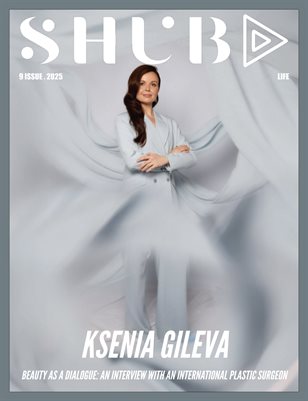Ksenia Gileva | Beauty as a Dialogue: An Interview with an International Plastic Surgeon
In frame: Ksenia Gileva | Photographer: Nika Kirillova | Producer: Kirill Zarin / Retoucher | Makeup and Hair Artist: Veronika Ramzaeva | Wardrobe Stylist: Tata Levina
Backstage Photographer: Elena Tarasova | Assistant: Andrey Balashov
What inspired you to choose plastic surgery, and how did you come to specialize in it?
At the stage of becoming, while studying medicine, I had one desire — to learn how to heal and help people, and to do it at the highest possible level.
In the first years at university, while studying theory, I wanted to understand it so deeply that even at that stage I could reduce the risks of possible complications — simply those that happen out of ignorance.
Then came practice — night shifts in emergency care, immersion into major surgery — and that’s when the love for surgery itself appeared.
You ask yourself: “Who am I — a therapist or a surgeon?”
And then begins a chain of fateful events, which, like an invisible thread, lead you along your professional path.
Knowledge, skill, experience — and at some point, it becomes the biggest part of your life.
And maybe it’s not you who chooses the profession — maybe it’s the profession that chooses you, guided by some of its own universal qualities.
What aesthetic trends in plastic surgery do you consider the most relevant in 2025?
The most relevant trend of all time is health.
Healthy skin, a healthy complexion, a healthy gaze, a healthy body, and a healthy mind.
All trends, modern techniques, and approaches should align with this principle.
Over the course of my practice, I’ve definitely learned not to blindly trust new, unproven methods.
Everything must have a solid foundation — logic, reasoning, and, above all, safety.
How do you balance a patient’s individual facial features and body type with commonly accepted standards of beauty and fashion?
It should always go hand in hand. Slavic faces don’t quite fit the “Korean approaches,” or only partially do!
A good tailor is someone who knows how to work with different materials and definitely understands how various fabrics (cotton, velvet, silk) behave both during work and afterwards.
It’s the same in plastic surgery! But beauty is different for everyone: the shape of the eyes, body silhouette, breast size.
It’s always essential to base everything on the patient’s preferences and to discuss these often not just verbally, but visually — by selecting pictures and photos of facial features and body shapes they aspire to.
How do you assess the role of social media in shaping modern beauty standards?
Nowadays, thanks to the widespread reach of online platforms, their influence is dominant.
Beautiful images, quick recoveries, no bruises or swelling… and suddenly a patient is shown after a major, complex surgery, rushing off to meet a friend at a restaurant for a cup of coffee.
But this is mostly an illusion.
Patients start to think that plastic surgery is like getting a manicure or eyelash extensions — and it’s absolutely not.
Of course, surgery today is truly at the highest level, allowing us to safely, quickly, and effectively work wonders and achieve dream results.
But it must be approached seriously, with respect for the laws of surgery and without harming health.
In your opinion, where is the line between natural aesthetics and the ‘Hollywood’ effect?
There is no line.
Beautiful Hollywood stars always strive to make their look genuinely natural, as if it’s from nature itself.
That’s why the “before and after” comparisons sometimes cause such a strong reaction — because we get so used to the stars’ faces that their “before” photos create an internal dissonance.
Through their “new,” yet already familiar appearance, we try to read their character and temperament, and it’s hard to imagine they were ever different.
That’s why Hollywood is never about excess — it’s always about harmony and authenticity.
What innovative techniques have you already implemented in your practice?
I always stay curious about new developments in my field and closely follow the emergence of breakthrough technologies.
Science, analysis, and hands-on practice are inseparable when it comes to being a true expert in your area.
A deep understanding of anatomy and proficiency in reconstructive techniques, including microsurgery, allow me to see and understand much more — and to approach many aesthetic procedures from a completely different perspective.
What was the most unusual request you’ve received in your practice? Could you tell us about that case?
Requests can be very different — especially when it comes to appearance and self-perception.
Some people want to look exactly like their idols, while others wish to transform completely — even to the point of changing gender.
One woman came in with a request: “I want a nose like my 5-year-old daughter’s.”
And all these desires have the right to exist, as long as they don’t contradict the person’s inner sense of self.
I approach such cases calmly and with great respect.
In your opinion, what are the essential ‘must-have’ procedures for those who want to look flawless in photos and on camera?
Improving skin quality — tone, evenness, and a healthy glow — for a “cosmetic Photoshop” effect
Correction of unwanted facial expressions with botulinum toxin therapy
Facial contouring and sculpting
Express treatments for quick skin refreshment
Which areas of aesthetic medicine and beauty do you see as the most promising in the next five years?
Minimally invasive techniques and cosmetic dermatology will come to the forefront. The priority will be quick results and fast recovery.







